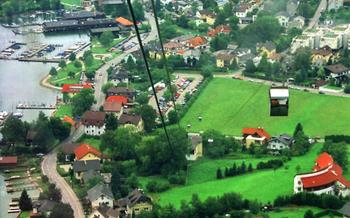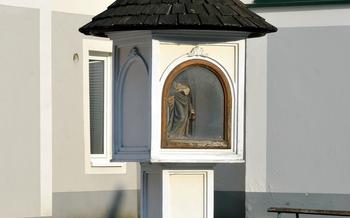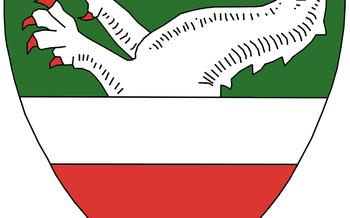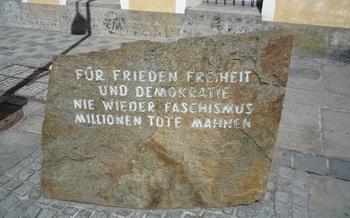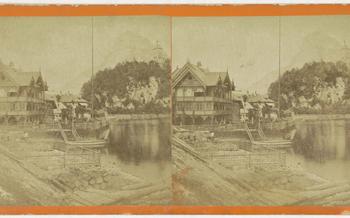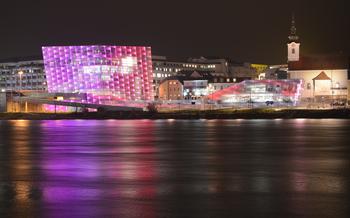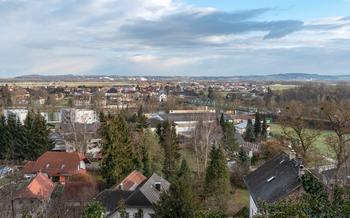
KZ Gedenkstätte Gusen
- KZ Gedenkstätte Gusen: A Monument to the Victims of Nazi Terror
- Exploring the Memorial Grounds
- The Liberation of Gusen
- Remembering the Victims
- The Gusen Trial
- The Quarry Memorial: A Silent Witness to Suffering and Resilience
- The Resistance Movement
- The Liberation of Gusen - Eyewitness Accounts
- KZ Gusen Memorial Museum: Preserving the Legacy of Human Suffering
- Commemorative Events and Ceremonies
- Insider Tip: Exploring Sankt Georgen an der Gusen
KZ Gedenkstätte Gusen: A Monument to the Victims of Nazi Terror
The KZ Gedenkstätte Gusen, located in the town of Sankt Georgen an der Gusen in Austria, stands as a solemn reminder of the horrors of the Nazi regime during World War II. Established in 1940 as a subcamp of the infamous Mauthausen concentration camp, Gusen became a site of unspeakable suffering and loss. The memorial site, meticulously preserved and maintained by the Gusen Memorial Committee, serves as a powerful tribute to the victims of Nazi atrocities and a poignant reminder of the resilience of the human spirit in the face of unimaginable darkness.
The memorial grounds encompass the preserved camp structures, including watchtowers, barracks, and the quarry where prisoners were forced to perform grueling labor. The central monument, a stark and imposing sculpture, symbolizes the immense suffering endured by the camp's inmates. Informative panels provide historical context and share the individual stories of prisoners, shedding light on their lives and experiences. Visitors are invited to explore the grounds at their own pace, reflecting on the atrocities committed and honoring the memory of those who perished.
Exploring the Memorial Grounds
The KZ Gusen Memorial Site is a serene and contemplative space that invites visitors to explore the preserved camp structures and learn about the history of the camp. The central monument, a striking sculpture, serves as a poignant reminder of the victims' suffering. Informative panels provide historical context and share individual stories of prisoners, humanizing the immense tragedy that unfolded within the camp's walls. The serene atmosphere of the memorial grounds encourages reflection and remembrance, allowing visitors to connect with the past and honor the lives lost.
The Liberation of Gusen
In May 1945, the tide of World War II turned decisively against Nazi Germany. As Allied forces advanced deeper into German-occupied territories, they encountered a network of concentration camps where unspeakable horrors had been perpetrated. Among these camps was KZ Gusen, a subcamp of the infamous Mauthausen complex.
On May 5, 1945, American troops from the 11th Armored Division rolled into Gusen, liberating the camp and its surviving prisoners. What the liberators witnessed was a scene of utter devastation and human suffering beyond imagination. Thousands of prisoners lay dead or dying, their bodies emaciated and ravaged by disease, starvation, and brutality. Mass graves filled with countless victims were discovered, a grim testament to the atrocities committed by the Nazi regime.
The liberators immediately set about providing medical care and assistance to the skeletal survivors, who were in desperate need of food, water, and medical attention. The camp was transformed into a makeshift hospital, with American medics working tirelessly to save as many lives as possible.
The liberation of Gusen marked a turning point in the history of the Holocaust and World War II. It exposed to the world the horrors of the Nazi concentration camp system and the systematic extermination of millions of innocent people. The camp's liberation also served as a stark reminder of the urgent need to bring the perpetrators of these crimes to justice and to ensure that such atrocities would never be repeated.
Remembering the Victims
Amidst the desolation and darkness of KZ Gusen, countless individual stories of resilience and suffering unfolded. These were not mere statistics but real people with names, families, and dreams tragically cut short by the horrors of the camp. It is crucial to remember and honor their lives, ensuring that their experiences are never forgotten.
Preserving their memory serves as a testament to their indomitable spirit and the atrocities they endured. By listening to their stories, we gain a deeper understanding of the human capacity for both cruelty and compassion. These accounts remind us of the importance of empathy, tolerance, and the fight against all forms of discrimination and oppression.
Education plays a vital role in preventing future atrocities. By teaching about the horrors of the Holocaust and specifically KZ Gusen, we can instill in future generations a sense of responsibility to stand up against tyranny and injustice. It is through education that we can break the cycle of hatred and violence and build a world where such atrocities never happen again.
Numerous initiatives are underway to document and share the stories of the victims of KZ Gusen. These efforts include collecting testimonies, conducting research, and creating educational materials. By preserving these invaluable accounts, we ensure that the legacy of the victims lives on, inspiring us to work towards a more just and compassionate world.
The Gusen Trial
The conclusion of World War II brought about a period of accountability and justice for the atrocities committed by the Nazi regime. Among the many trials that took place, the Gusen Trial holds a significant place in addressing the crimes perpetrated at the KZ Gusen concentration camp.
Postwar Justice
In the aftermath of the war, the Allies established war crimes tribunals to prosecute those responsible for the horrific acts that had taken place. The Gusen Trial, held in Dachau, Germany, in 1946-1947, specifically focused on the crimes committed at KZ Gusen and its subcamps.
Accountability and Evidence
The trial brought to justice former SS personnel who held positions of authority at Gusen, including the camp commandant, Arthur Liebehenschel, and other high-ranking officers. The prosecution presented a substantial body of evidence, including witness testimonies from survivors, documentary records, and physical evidence gathered from the camp.
Challenges and Significance
The Gusen Trial faced several challenges, including the difficulty of gathering evidence and the reluctance of some witnesses to come forward due to fear or trauma. Despite these obstacles, the trial succeeded in establishing the guilt of many of the accused, resulting in convictions and sentences ranging from death to imprisonment.
Local Impact and Reconciliation
The trial had a profound impact on the local community of Sankt Georgen an der Gusen, where the camp was located. The proceedings brought to light the extent of the atrocities committed in their midst, forcing them to confront the dark chapter in their town's history. The trial also contributed to the broader process of reconciliation, acknowledging the suffering inflicted by the Nazi regime and seeking to promote healing and understanding.
The Quarry Memorial: A Silent Witness to Suffering and Resilience
Location and Significance:
In the vicinity of KZ Gusen, a somber memorial stands as a silent witness to the unspeakable suffering endured by countless prisoners during the dark days of World War II. The Quarry Memorial marks the site of a brutal quarry where prisoners were forced to toil under inhumane conditions, their lives reduced to mere commodities in the Nazi regime's ruthless machinery of oppression.
Harsh Conditions and Grueling Labor:
The quarry, with its unforgiving terrain and treacherous conditions, became a symbol of the prisoners' relentless struggle for survival. Deprived of basic necessities, subjected to relentless beatings and abuse, they were forced to extract granite blocks from the earth, their bodies weakened by malnutrition and disease. The quarry became a place of unspeakable horrors, where the boundaries of human endurance were tested to their limits.
Memorial to the Fallen:
As a tribute to the countless lives lost in the quarry, a memorial was erected to honor their memory and serve as a poignant reminder of the atrocities committed. The memorial features a simple yet powerful design, capturing the essence of the prisoners' suffering and resilience. It stands as a solemn testament to the indomitable human spirit, even in the face of unimaginable adversity.
Preserving Historical Significance:
The preservation of the quarry site is of utmost importance, as it serves as a tangible link to the past, a physical reminder of the horrors that unfolded within its confines. Ongoing efforts are underway to ensure that the site remains intact, allowing future generations to bear witness to the atrocities committed during the Nazi regime and to honor the memory of those who perished in the quarry.
The Resistance Movement
Within the confines of KZ Gusen, a flicker of defiance burned bright: a resistance movement, organized by prisoners determined to fight back against their oppressors. The challenges they faced were immense—secrecy was paramount, and the consequences of discovery were dire. Yet, undeterred, these brave souls found ways to resist, undermining the camp's operations and providing a beacon of hope to their fellow prisoners.
Acts of sabotage became their weapon of choice—small, calculated gestures that disrupted the camp's machinery and sowed seeds of doubt among the SS. They tampered with tools, slowed down work processes, and even managed to organize a strike in one of the quarries. Their actions, though seemingly insignificant, were a powerful reminder that the human spirit could not be extinguished, even in the darkest of places.
The existence of the resistance movement within Gusen is a testament to the indomitable will of the prisoners. It served as a source of inspiration and strength, proving that even in the face of unimaginable suffering, the desire for freedom and justice could not be quelled.
The Liberation of Gusen - Eyewitness Accounts
The liberation of KZ Gusen by American troops on May 5, 1945, marked a pivotal moment in the camp's history. Survivors' firsthand accounts and testimonies provide invaluable insights into the emotional and physical state of the prisoners during this momentous event.
Eyewitnesses described the skeletal figures, barely clinging to life, who emerged from the camp gates. The liberators were met with scenes of unimaginable suffering, as thousands of emaciated and diseased prisoners lay scattered throughout the camp. The survivors were overwhelmed with emotions, ranging from disbelief and shock to gratitude and relief.
The liberators immediately set up a field hospital and provided medical care to the liberated prisoners. The survivors were given food, clothing, and shelter, and efforts were made to reunite them with their families. The process of healing and recovery began, but the physical and emotional scars left by their experiences at Gusen would remain with them for a lifetime.
These eyewitness accounts serve as powerful reminders of the atrocities committed at Gusen and the resilience of the human spirit. They offer a glimpse into the lives of the victims and the unimaginable suffering they endured, shedding light on one of the darkest chapters in human history.
KZ Gusen Memorial Museum: Preserving the Legacy of Human Suffering
At the heart of the KZ Gusen memorial site stands a poignant reminder of the atrocities committed during World War II – the KZ Gusen Memorial Museum. Established in 1997, the museum serves as a repository of the camp's history, preserving the memory of those who suffered and perished within its walls.
As visitors step into the museum, they are confronted with a sombering collection of artifacts, personal belongings, and poignant exhibits that narrate the harrowing experiences of the camp's prisoners. Through photographs, documents, and interactive displays, the museum provides a comprehensive account of the camp's establishment, operation, and liberation.
Among the artifacts on display are remnants of the prisoners' daily lives, such as their meager clothing, worn-out shoes, and crudely crafted utensils. These personal items offer a tangible connection to the individual stories of suffering and resilience that unfolded within the camp's confines.
In addition to its permanent exhibits, the museum also hosts temporary exhibitions that delve deeper into specific aspects of the camp's history. These exhibitions often feature guest speakers, survivor testimonies, and educational programs that foster a deeper understanding of the events that transpired at Gusen.
Through its exhibits and educational initiatives, the KZ Gusen Memorial Museum plays a crucial role in preserving the legacy of the camp and ensuring that the victims' stories are never forgotten. It serves as a powerful reminder of the horrors of the Nazi regime and the importance of fighting against intolerance, hatred, and oppression in all its forms.
Commemorative Events and Ceremonies
Every year, the KZ Gedenkstätte Gusen memorial site hosts commemorative events to honor the victims of the Nazi atrocities committed at the camp. These events serve as solemn occasions for survivors, their families, representatives of various organizations, and the local community to come together and remember the lives lost.
During these commemorative ceremonies, wreaths are laid, speeches are given, and prayers are offered in memory of the victims. The names of those who perished are read aloud, ensuring that they are never forgotten. These events provide a space for reflection, remembrance, and reconciliation.
The participation of survivors and their families in these ceremonies adds a profound personal dimension to the commemorations. Their presence serves as a powerful reminder of the suffering endured and the resilience demonstrated by those who survived the horrors of the camp.
Commemorative events at the KZ Gedenkstätte Gusen are not only acts of remembrance but also affirmations of the importance of learning from the past. They underscore the need to combat intolerance, hatred, and discrimination in all its forms to prevent future atrocities.
By attending these ceremonies, visitors can pay their respects to the victims, honor their memory, and reaffirm their commitment to promoting peace, understanding, and human rights.
Insider Tip: Exploring Sankt Georgen an der Gusen
For a more comprehensive understanding of the history of KZ Gusen, consider exploring the nearby town of Sankt Georgen an der Gusen, which played a significant role in the camp's operation.
Visit the former SS barracks, now used as a retirement home, to gain insight into the lives of the perpetrators. The local history museum delves deeper into the town's connection to the camp, showcasing artifacts and documents that shed light on this dark chapter.
When engaging with the local community, approach conversations with sensitivity and respect. Remember that the legacy of the camp is a delicate subject for many residents. Thoughtful dialogue can foster a deeper understanding of the town's history and its relationship to the memorial site.

